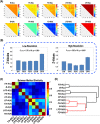Convergence and divergence across construction methods for human brain white matter networks: an assessment based on individual differences
- PMID: 25641208
- PMCID: PMC6869604
- DOI: 10.1002/hbm.22751
Convergence and divergence across construction methods for human brain white matter networks: an assessment based on individual differences
Abstract
Using diffusion MRI, a number of studies have investigated the properties of whole-brain white matter (WM) networks with differing network construction methods (node/edge definition). However, how the construction methods affect individual differences of WM networks and, particularly, if distinct methods can provide convergent or divergent patterns of individual differences remain largely unknown. Here, we applied 10 frequently used methods to construct whole-brain WM networks in a healthy young adult population (57 subjects), which involves two node definitions (low-resolution and high-resolution) and five edge definitions (binary, FA weighted, fiber-density weighted, length-corrected fiber-density weighted, and connectivity-probability weighted). For these WM networks, individual differences were systematically analyzed in three network aspects: (1) a spatial pattern of WM connections, (2) a spatial pattern of nodal efficiency, and (3) network global and local efficiencies. Intriguingly, we found that some of the network construction methods converged in terms of individual difference patterns, but diverged with other methods. Furthermore, the convergence/divergence between methods differed among network properties that were adopted to assess individual differences. Particularly, high-resolution WM networks with differing edge definitions showed convergent individual differences in the spatial pattern of both WM connections and nodal efficiency. For the network global and local efficiencies, low-resolution and high-resolution WM networks for most edge definitions consistently exhibited a highly convergent pattern in individual differences. Finally, the test-retest analysis revealed a decent temporal reproducibility for the patterns of between-method convergence/divergence. Together, the results of the present study demonstrated a measure-dependent effect of network construction methods on the individual difference of WM network properties.
Keywords: connectome; diffusion MRI; graph theory; individual difference; inter-subject variability; test-retest.
© 2015 Wiley Periodicals, Inc.
Figures








References
-
- Bassett DS, Brown JA, Deshpande V, Carlson JM, Grafton ST (2011): Conserved and variable architecture of human white matter connectivity. Neuroimage 54:1262–1279. - PubMed
-
- Bastiani M, Shah NJ, Goebel R, Roebroeck A (2012): Human cortical connectome reconstruction from diffusion weighted MRI: The effect of tractography algorithm. Neuroimage 62:1732–1749. - PubMed
-
- Batalle D, Eixarch E, Figueras F, Munoz‐Moreno E, Bargallo N, Illa M, Acosta‐Rojas R, Amat‐Roldan I, Gratacos E (2012): Altered small‐world topology of structural brain networks in infants with intrauterine growth restriction and its association with later neurodevelopmental outcome. Neuroimage 60:1352–1366. - PubMed
Publication types
MeSH terms
LinkOut - more resources
Full Text Sources
Other Literature Sources

